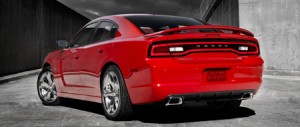Victoria Beckham helped with the interior design; we’re not sure if David signed off the chassis…
The new Evoque is the smallest, lightest, most fuel-efficient Range Rover ever. There’s even a two-wheel-drive version for even lower CO2 emissions; with the lower-powered of the two available 2.2-liter diesels on board, that’ll give a most un-SUV-like 58mpg (4.9L/100km).
Work on Evoque began in 2007, after research revealed some white space in the market now starting to be filled by the likes of the BMW X1, MINI Countryman, and Audi Q3. What became the Evoque was confirmed for production after the favorable reaction to the LRX Detroit show car at the start of 2008.
LRX was based on a Freelander, and that platform was the starting point for the Evoque’s engineering team under Murray Dietsch, previously chief program engineer, and now director of all Land Rover programs.
“We’ve since changed up to 70% of the platform, for two reasons,” Dietsch tells VDI. “The first was that we wanted a desirable car, which meant changing the stance: we had to lower the body on the suspension. But we still wanted to give tall people sufficient space in the back, which meant further changes to the rear of the car. It’s about 150mm shorter than a Freelander and 120mm lower, so it’s a more compact vehicle.
“The other reason we changed the platform was the big push on sustainability and improving fuel economy. A lot of the underbody components have been changed to take weight out of the car. It has aluminum knuckles and lower control arms, and the first electric power steering application for any Jaguar or Land Rover car, so the front of the car needed a new subframe to accommodate a new steering system.”
In all, the weight-loss program took around 100kg out of Evoque compared to a Freelander. The body structure is about 35kg lighter through the use of ultra-high-strength steels and boron steels, as well plastics for the tailgate and fenders, and aluminum for the hood and roof, which also helps lower the center of gravity.
Suspension-wise, the newcomer has a proven, coilover MacPherson strut arrangement all-around, with lower control arms at the front and trailing arms at the rear. “It works well on Freelander and does all of what we need it to do off-road and in terms of durability,” says Dietsch. “All we’ve done is optimized the geometry and taken weight out.”
The EPS is a ZF rack-drive system. “We were initially a bit sceptical on whether we were going to get the ultimate dynamics that we wanted out of the steering,” he reveals, “because some of the early EPS systems feel a bit disconnected, a bit wooden. But I have to say that with the tune we’ve been able to achieve from the belt-drive system on Evoque, people will not be able to tell that it’s not hydraulic.”
The brake setup includes 16 or 17in discs and a Conti Teves ABS/ESC system that’s a generation on from the one in the Freelander. Additional functions such as hill hold are included, and Dietsch says that increased memory capacity in the ECU has helped improve some of the Terrain Response functions. There’s also an EPB with driveaway release; engineers are considering an automatic engagement system for when ‘Park’ is selected in the automatic gearbox.
There will be three wheel sizes available: 18in, 19in or an optional 20in rim. “I’m not sure what the take rate’s going to be; I suspect that most people will go for the optional wheels and tires,” says Dietsch, recognizing the style-conscious nature of the vehicle. “All of them have been designed with our off-road capability in mind; even the 20in ones are not a road-only combination and still have the prescribed sidewall height for sharp edges, etc.
“We’ve had to change the suspension in some cases to cater for the bigger outer diameter, and we have different suspension tunes for the different wheel and tire combinations. BWI’s MagneRide suspension as also an option, which gives us an infinite amount of tune, so we can have a ‘dynamic’ mode too. When you select it, the illumination on the dashboard instrumentation turns to red – just because you can, I guess!”
So is it still a Range Rover? “Given its looks it needs to have a blend of on-road dynamics and off-road capability,” he reasons. “I don’t anticipate that people will ever take it too far off-road, but if they do, it won’t disgrace itself. And it can’t, because it’s a Range Rover. It’s even got more ground clearance on the underside than a Freelander, despite the fact that the body is lower.”
Author : Graham Heeps





































